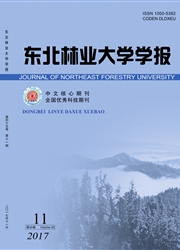

 中文摘要:
中文摘要:
利用LandSat5-TM对竹林遥感信息提取方法进行了研究:将归一化植被指数NDV1、结构效应指数CVI、综合效应指数MVI以及主成分变换的前3个分量PCA1、PCA2、PCA3与TM数据的6个波段(除第六波段)合成一个具有12波段的新数据;在最佳波段组合的基础上,结合地形图、土地利用图和野外调查数据,采用光谱特征模型、支持向量机、光谱角填图以及最大似然法对竹林信息进行了提取。研究表明:叶冠结构指数、综合指数、主成分变换等新波段对竹林信息提取很有帮助;与支持向量机、光谱角填图和最大似然法3种监督分类方法相比,基于光谱特征模型的竹林遥感信息提取方法具有一定的适应性,在保证竹林分类精度的同时,其他植被类型的分类精度也能得到满意的结果。
 英文摘要:
英文摘要:
The paper deals with the extraction of bamboo forest information based on Landsat5 - TM data. Firstly, a new set of data with twelve bands were obtained by combining Normalized Difference Vegetation Index ( NDV1 ) , Canopy Vegetation Index( CVI ) ,Multi Vegetation Index(MVI ), the first three components before principal component transform processing with six bands of TM data ( except band 6 ). Then, the optimal band combinations of false color based on OIF and fraetal dimension has been analyzed, and Spectral Feature Model (SFM), Support Vector Machine (SVM), Spectral Angle Mapper (SAM) and Maximum Likelihood (ML) were used to extract the remote sensing information of bamboo forests in accordance with topographical map, land use map, and field investigation data. Results show that CVI, MVI and principal component transform are some important bands for extracting bamboo information from remote sensing data. The SFM has higher classification precision than the other three methods ; it ensures not only the classification precision of bamboo forests, but also a satisfactory classification result for other vegetation types such as coniferous forests.
 同期刊论文项目
同期刊论文项目
 同项目期刊论文
同项目期刊论文
 The responses of Moso Bamboo (Phyllostachys heterocycla var. pubescens) forest aboveground biomass t
The responses of Moso Bamboo (Phyllostachys heterocycla var. pubescens) forest aboveground biomass t 期刊信息
期刊信息
